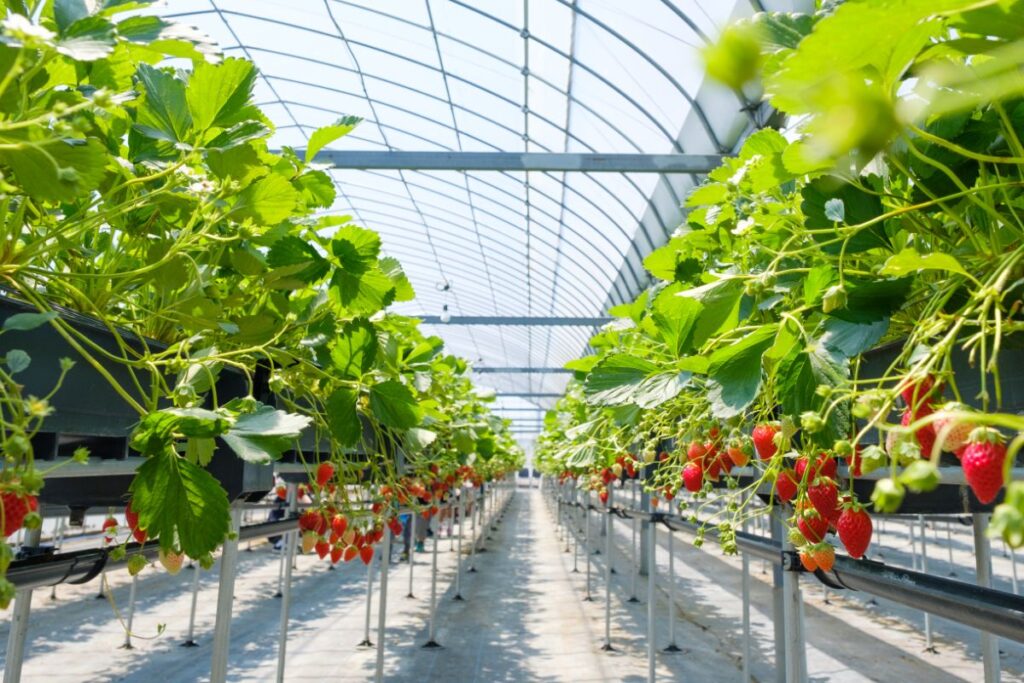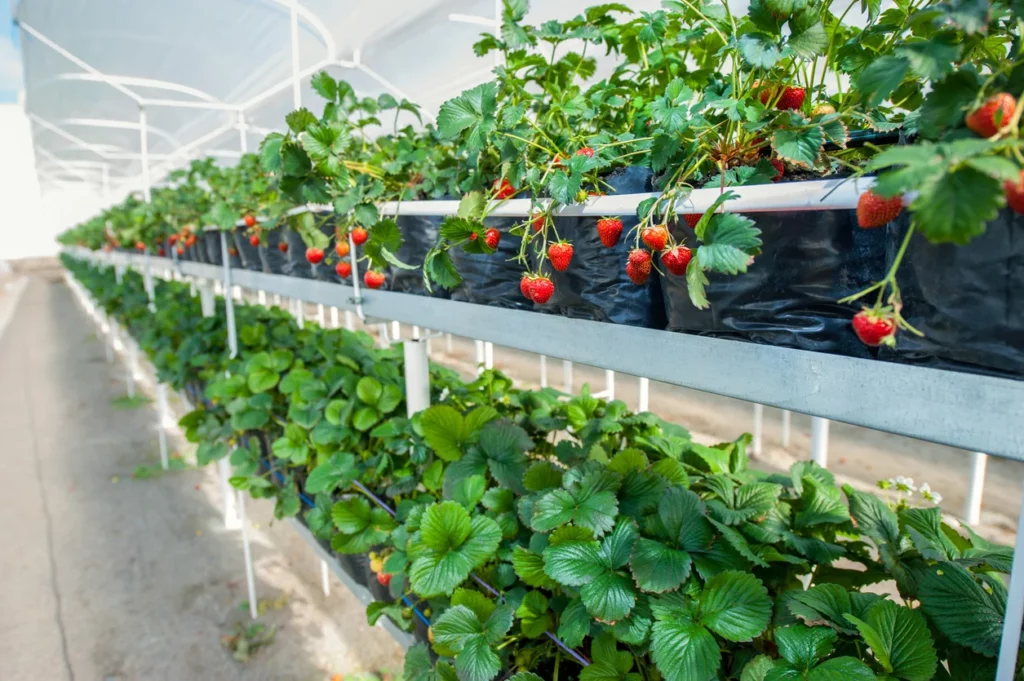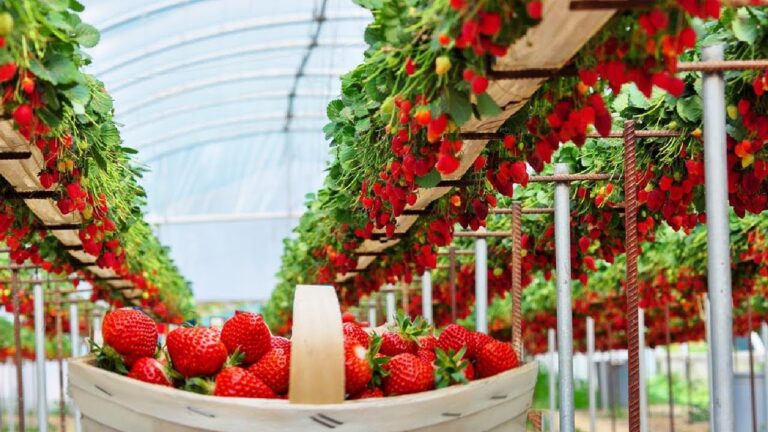One sunny spring morning, I was in my greenhouse, surrounded by rows and rows of green strawberry plants. The air smelled so sweet, like a strawberry candy factory. That’s when it hit me: growing strawberries in a greenhouse is like making magic happen.
And now, I want to share the secret with you. Join me on this journey as we discover how to grow strawberries in a greenhouse, step by step. It’s going to be fun and fruitful!
To grow strawberries in a greenhouse:
- Choose day-neutral varieties for extended growing seasons.
- Ensure proper greenhouse conditions, including ventilation.
- Use containers or raised beds with well-draining soil.
- Plant in spring or late summer, space 12-18 inches apart.
- Maintain consistent soil moisture, avoiding overhead watering.
- Apply balanced, slow-release fertilizer and mulch.
- Prune, thin, and monitor for pests and diseases.
- Hand-pollinate due to the lack of natural pollinators.
- Harvest ripe strawberries gently.
- Care for plants year-round, including winter protection.
How to Optimize Greenhouse Preparation for Success?

Setting the stage for greenhouse success begins with meticulous preparation – here’s how to optimize every step.
Greenhouse Condition Assessment
Inspect the greenhouse structure for any damage, leaks, or wear and tear that may compromise its integrity. In addition, check the integrity of the glazing material (glass or plastic) to ensure it provides proper insulation and light transmission.
Assess the orientation of the greenhouse to maximize sunlight exposure while minimizing exposure to harsh weather conditions. Moreover, ensure that there are no obstructions inside the greenhouse that may block sunlight or airflow.
Ventilation and Climate Control
Install proper ventilation systems, including roof vents, side vents, or exhaust fans, to regulate temperature and humidity. Furthermore, implement automated climate control systems with sensors for temperature, humidity, and CO2 levels to maintain optimal conditions.
Consider shading systems to prevent overheating during the peak of summer. Install a heating system for colder months to prevent frost damage.
Temperature and Humidity Management
Maintain daytime temperatures between 65°F to 75°F (18°C to 24°C) for strawberry growth.
Nighttime temperatures can drop slightly, ideally between 50°F to 60°F (10°C to 15°C).
Furthermore, keep humidity levels around 60-70% to reduce the risk of fungal diseases and ensure proper transpiration.
What Are the Best Strawberry Varieties to Choose?
When it comes to selecting strawberry varieties, making the right choice can make all the difference in your greenhouse garden’s success.
Everbearing and Day-Neutral Varieties
Everbearing varieties produce two main crops each year: one in late spring and one in early fall. Day-neutral varieties produce fruit continuously throughout the growing season, making them ideal for greenhouse cultivation.
In addition, select specific cultivars known for their performance in greenhouses, such as ‘Albion’ or ‘Seascape.’
Considerations for Greenhouse Cultivation
Greenhouse strawberries require varieties that adapt well to controlled environments.
Factors to consider include disease resistance, fruit quality, yield potential, and growth habit.
How to Prepare Containers and Soil for Successful Gardening?
Before your gardening journey begins, discover the essential steps to prepare containers and soil for a thriving, bountiful harvest.
Choosing Containers or Raised Beds
Containers, such as grow bags or hanging baskets, offer excellent control over soil quality and are space-efficient.
Moreover, raised beds can be constructed using treated lumber or other materials and are suitable for larger-scale greenhouse operations.
Soil Selection and Preparation
Use a well-draining potting mix rich in organic matter. Consider incorporating coconut coir or perlite to improve drainage and aeration.
Additionally, conduct a soil test to assess nutrient levels and make necessary amendments.
Soil pH and Fertility Considerations
Aim for a slightly acidic soil pH of around 6.0 for optimal strawberry growth. Fertilize based on soil test results, typically with a balanced, slow-release fertilizer.
Moreover, organic amendments like compost or aged manure can enhance soil fertility while improving its structure.
What Are the Key Steps for Successful Planting?
To set the foundation for a fruitful greenhouse strawberry garden, follow these key steps for successful planting.
Timing for Planting (Spring or Late Summer)
Spring planting is suitable for most regions and allows strawberries to establish roots before hot weather arrives.Late summer planting, typically in August or early September, can provide an early fall crop.
However, it requires careful attention to temperature and humidity control in the greenhouse.
Choose the timing based on your climate and the strawberry variety’s specific requirements.
Proper Spacing and Planting Depth
Adequate spacing is crucial for healthy strawberry plants. Space them 12 to 18 inches (30 to 45 centimeters) apart in rows with about 3 feet (90 centimeters) between rows.
Plant strawberries at the same depth they were growing in their previous container or nursery, with the crown (the point where the roots meet the leaves) level with the soil surface. Planting too deep or too shallow can lead to root and crown issues.
Positioning the Crown at Soil Level
Ensuring the crown is at the soil level prevents it from rotting or drying out. Planting too deep can bury the crown, increasing the risk of diseases. Planting too shallow can expose the crown, making it vulnerable to damage.
How to Optimize Watering and Irrigation for Healthy Plants?
Maintaining healthy greenhouse strawberry plants hinges on mastering the art of watering and irrigation.
Maintaining Consistent Moisture
Monitor soil moisture regularly and aim to keep it consistently moist but not waterlogged.
In a greenhouse, evaporation rates can be higher, so be attentive to moisture levels, especially during warm weather.
Adjust the watering frequency based on weather conditions and the growth stage of the strawberries.
Drip Irrigation and Soaker Hoses
Drip irrigation systems deliver water directly to the root zone, reducing water wastage and minimizing the risk of fungal diseases.
Moreover, soaker hoses also provide even moisture distribution but are placed on the soil surface and allow water to seep slowly into the root zone. Both systems help maintain consistent soil moisture and reduce weed growth.
Preventing Waterlogging and Avoiding Overhead Watering
Overwatering or poor drainage can lead to waterlogged soil, which can suffocate strawberry roots and promote disease.
In addition, avoid overhead watering, especially late in the day, as it can encourage fungal diseases. Instead, focus on directing water to the root zone.
What’s the Best Approach to Fertilization for Thriving Plants?

Unlock the secret to thriving greenhouse strawberry plants with the right fertilization approach.
Choosing Appropriate Fertilizers
Select a balanced, slow-release fertilizer with a formulation like 10-10-10 or 14-14-14, which provides essential nutrients for strawberry growth. Furthermore, consider using controlled-release granular fertilizers for a consistent nutrient supply.
Application Schedule and Methods
Apply fertilizer according to the recommended schedule, typically in early spring and again after the first fruiting. Distribute fertilizer evenly around the plants, keeping it away from the crowns to prevent burning.
Moreover, follow the specific fertilizer manufacturer’s instructions for application rates.
Organic Fertilizer Options
Organic fertilizers like compost, well-rotted manure, or fish emulsion can be used in place of synthetic fertilizers. Moreover, organic fertilizers also improve soil health and microbial activity.
Incorporate organic matter into the soil when planting or as a top dressing during the growing season.
What Are the Pruning and Thinning Techniques for Ideal Growth?
For ideal growth and robust strawberry yields in your greenhouse, mastering pruning and thinning techniques is essential
Regular Maintenance for Healthy Plants
Regular pruning and thinning are essential for maintaining healthy and productive strawberry plants.
Moreover, pruning encourages better air circulation, reduces disease pressure, and focuses plant energy on fruit production.
Removing Dead or Yellowing Leaves
Prune away dead, yellowing, or diseased leaves as soon as you notice them.
These leaves can harbor pests and diseases, and their removal improves overall plant health.
Controlling Runners for Increased Fruit Production
Runners are long, trailing stems that strawberry plants produce. While they can be used to propagate new plants, too many runners divert energy away from fruit production.
Control runners by snipping or pinching them off as they appear. This redirects the plant’s energy toward producing larger, juicier berries.
When Is the Perfect Time for Harvesting Strawberries?
Timing is everything when it comes to harvesting strawberries in your greenhouse.
Identifying Ripe Strawberries
- Ripe strawberries should be fully red, with no green or white areas.
- The berries should be firm and plump, indicating they are at their peak of sweetness.
- Check for a uniform red color and a glossy appearance.
- Gently squeeze the berry; it should yield slightly to pressure without being mushy.
Gentle Harvesting Methods to Prevent Damage
- When harvesting strawberries, use a small pair of scissors or pruning shears to cut the stem just above the fruit.
- Avoid pulling or twisting the berries, as this can damage the plant and the fruit.
- Handle strawberries delicately to prevent bruising or crushing, which can lead to spoilage.
What Does Continual Care Involve for Strawberry Plants?
Continual care is the backbone of a flourishing greenhouse strawberry garden – explore the essential tasks and techniques for ongoing plant health.
Supporting Trailing Varieties
Some strawberry varieties have trailing growth habits, meaning they produce long runners. Support these varieties by using trellises, hanging baskets, or elevated containers to keep the fruit off the ground. Additionally, secure the runners to prevent them from becoming entangled and crowding the plant.
Maintaining Proper Environmental Conditions
Continuously monitor and control temperature and humidity levels in the greenhouse to create an optimal growing environment. Moreover, ensure adequate air circulation to prevent fungal diseases and encourage robust plant growth.
In addition, maintain proper light levels, typically 10-12 hours of sunlight or equivalent artificial lighting.
Year-Round Care, Including Winter Protection
In cold climates, provide winter protection to greenhouse strawberries to prevent frost damage. Moreover, insulate the greenhouse with additional layers of insulation, such as bubble wrap or row covers.
Adjust heating and ventilation systems to maintain a suitable temperature during the winter months. Prune and remove old leaves in late fall to reduce disease pressure during the winter.
FAQ’s
What is the best soil for greenhouse strawberries?
The best soil for greenhouse strawberries is a well-draining potting mix with a slightly acidic pH (around 6.0) that is rich in organic matter. Adding perlite or coconut coir can improve drainage and aeration.
What climate do strawberries grow best in?
Strawberries grow best in temperate climates with mild winters and moderate summers. They thrive in areas with temperatures between 60°F to 80°F (15°C to 27°C) during the growing season.
What is the yield of strawberries in a greenhouse?
The yield of greenhouse-grown strawberries can vary widely depending on factors like variety, care, and environmental conditions. On average, you can expect to harvest 0.5 to 1 pound (0.2 to 0.45 kilograms) of strawberries per plant per growing season.
What is the best fertilizer for strawberries?
A balanced, slow-release fertilizer with a formulation like 10-10-10 or 14-14-14 is suitable for strawberries. Organic options, such as compost or aged manure, can also provide excellent nutrition for strawberry plants.
What is the best container for growing strawberries?
Containers like grow bags, hanging baskets, or raised beds work well for growing strawberries in a greenhouse. The choice depends on space and personal preference, but containers offer better control over soil quality.
What country do strawberries grow best?
Strawberries are grown successfully in various countries, but some of the top strawberry-producing countries include the United States, Mexico, Spain, Poland, and Egypt. The ideal growing conditions may vary by region within each country.
Conclusion
In summary, after delving into the intricacies of greenhouse strawberry cultivation, I have come to appreciate the multifaceted nature of this endeavor. From the meticulous greenhouse preparation and selection of suitable strawberry varieties to the art of proper planting, watering, and fertilization, it’s clear that success hinges on attention to detail.
Mulching, pruning, and vigilant pest management play pivotal roles in maintaining plant health and maximizing yields. Moreover, the absence of natural pollinators underscores the significance of hand pollination in this controlled environment.
Harvesting, a moment of anticipation, demands a gentle touch, while continual care, especially during the winter months, ensures a year-round supply of delicious strawberries. Greenhouse strawberry cultivation offers not only extended growing seasons but also a rewarding journey of nurturing these delectable fruits from start to finish.

